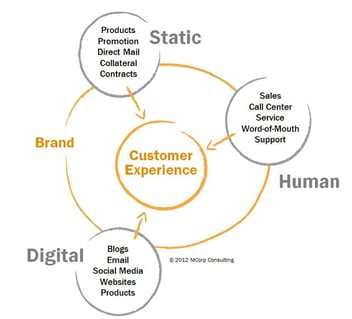In a company of scale, it’s easy to allow a discussion of touchpoints to descend into paralyzing complexity; we regularly work with companies whose touchpoint inventories reach into the hundreds, and sometimes beyond. When external touchpoints (those in the growing portion of the customer experience that is outside your control, such as social media) are brought into the mix, it can get even more confusing. You need a way to sort through the possibilities.
Without An Understanding Of Your Touchpoints, You Cannot Improve Customer Experience
It’s no secret that the ways customers interact and gather information about your company is changing. Businesses, buyers and consumers demand more and get it from more places than ever. Even so, many companies don’t have a clear picture of all the ways they touch their customers, much less the ways that others do so on their behalf. Yet touchpoints are the front line when it comes to cohesive, simple experience design and delivering on your CX goals.
 Even within the context of a broader, corporate initiative around improving customer experience, this lack of knowledge about your company’s touchpoints means that you tacitly (and usually unconsciously) are ceding control of the touchpoints that influence customer experience and perceptions of your brand. Even if your customer experience strategy is well defined, the implementation of that strategy is dependent on your knowledge of exactly what your touchpoints are, and how well those touchpoints meet customer needs.
Even within the context of a broader, corporate initiative around improving customer experience, this lack of knowledge about your company’s touchpoints means that you tacitly (and usually unconsciously) are ceding control of the touchpoints that influence customer experience and perceptions of your brand. Even if your customer experience strategy is well defined, the implementation of that strategy is dependent on your knowledge of exactly what your touchpoints are, and how well those touchpoints meet customer needs.
Mapping Where (And How) You Touch Your Customers
While there are multiple inputs required to define strategy for overall CX improvement, an understanding of touchpoint performance (and what your touchpoints are) is a great place to start. You can (and should) do this on a smaller scale first, by focusing on touchpoint and journey mapping for a product line, division, or customer segment; for most companies, starting more broadly is simply too much.
Besides, you’ll need to prove out the value. That’s why it’s nice to know you’re almost guaranteed a defensible business case—as well as a handful of quick wins (high-impact and low-resource requirements) by diving deeply into a single area.
Under the umbrella terms of journey mapping and customer experience management, the surest path is to map the customer’s relationship with your firm across the customer relationship life cycle that is unique to your industry and your company.
One of the most common ways is customer journey mapping, a qualitative approach that helps your firm see where and how a specific customer interacts with you. Journey maps typically describe the experience in narrative format, and include observations of touchpoints encountered by life cycle stage, as well as customer perceptions and emotions. Building on the insights gained through journey mapping, “Touchpoint Mapping” delivers quantitative data, associating performance metrics with each touchpoint, as well as the sequence of touchpoints encountered (“touchpoint paths”). Touchpoint Mapping includes a high level of detail to help identify current states and prioritize specific CX improvement opportunities.
No matter how you do it, understanding touchpoints—identifying them all, controlling those you can, and influencing those you cannot—is a defining factor in your ability to better serve smart customers, deliver a better customer experience, and drive customer loyalty in the fast-moving years to come.
Will You Control Your Touchpoints, or Will You Allow Them to Control You?
Today, disruptive forces are forever changing customer expectations. To help you navigate this world, you need a lens through which to judge the quality and consistency—and the existence—of touchpoints that contribute to perceptions of your firm.
Whether the lens you use is customer journey mapping, Touchpoint Mapping, or, most likely, a combination of methods, the importance of understanding your touchpoints cannot be overstated.
In this world, social influence means that others are being inserted into the relationship between you and your customers. Increasingly smart, digitally enabled touchpoints have the ability to provide personalized services, gather valuable data, and simplify the process of serving customers. Your firm has the ability to leverage your touchpoints to remember everything about your customers—and build this knowledge into customer experience design for their benefit, as well as yours.
The bottom line is simple to understand, though, I recognize, a lot of work to execute: Companies must immediately evaluate the ways they touch, influence, and serve customers. Once this understanding is gained, you’ll have the insights you need to prioritize opportunities to improve. Fix touchpoints that underperform. Remove touchpoints that are unimportant. Add touchpoints that are missing. Identify new opportunities to make touchpoints smart.
After all, without a clear understanding of customer experience at the touchpoint level today, it’s going to be very difficult to improve customer experience tomorrow.

